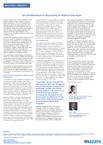Tax Considerations in Accounting for Right-of-Use Asset
Cost is a major factor for most companies when deciding whether to buy an asset or opt for a lease arrangement. For a lot of organizations, leasing the asset has always been the most favorable option as it is beneficial for cash flow management. Some other factors are considered, such as frequent technological upgrades and reduced ownership responsibilities, when companies are considering leasing an asset or an outright purchase.
A lease is an agreement wherein a lessor (owner) lets out an asset to a lessee in exchange for a consistent rental payment for an agreed period. There are two types of lease arrangements, viz: finance lease and operating lease. A lease is usually classified as a finance lease if the arrangement transfers substantially all the risks and rewards incidental to ownership of an underlying asset to the lessee. Otherwise, the lease is classified as an operating lease.
The International Financial Reporting Standard (IFRS) 16 on accounting for leases recommends a single lease accounting model, requiring a lessee to recognize a Right-of-Use (ROU) asset and a lease liability for all leases unless the lease term is 12 months or less, or the asset has a low value.
Overview of the Recognition and Measurement Requirements
ROU asset is the right available to a lessee to use an asset over the life of a lease. Upon initial recognition, the ROU asset is measured at the present value of the initial lease liability, initial direct costs incurred relating to the lease, lease payments made by the lessee (if any) to the lessor prior to the date the lease commences, less all lease incentives received. In addition, an estimate of any dismantling, removal or restoration costs incurred by the lessee may be considered.
Based on IFRS 16, a lessee shall measure the ROU asset using cost model, unless the ROU asset is an investment property or is being revalued along with other items of property, plant and equipment in line with IAS 16’s revaluation model. Under the cost model, ROU asset is measured at cost less accumulated depreciation and accumulated impairment. The ROU asset is subsequently depreciated from the start date of the lease to the end of the lease term or the end of the useful life of the asset (whichever is earlier). However, where it is certain that the lessee will opt for the purchase of the asset, the amortization period will be from the lease commencement date to the end of the asset’s useful life.
On the other hand, the lease liability is treated as a financial liability and measured at amortized cost using the interest rate implicit in the lease as the effective interest rate. It is initially measured at the present value of the lease rentals payable over the lease term and discounted at the interest rate implicit in the lease arrangement if that can be readily determined. If the interest rate cannot be readily determined, the lessee shall use their incremental borrowing rate. The lease liability is spread over the lease term and released to the income statement.
Tax Considerations
The Federal Inland Revenue Service (FIRS) Information Circular No. 2010/01 (the circular) titled “Guidelines on the Tax Implication of Leasing” provides a detailed guidance on the tax implication of finance and operating leases for both the lessor and lessee. The circular was issued in pursuant to paragraph 18(2) of the second schedule of the Companies Income Tax Act (CITA) which provides for the legal basis for the tax treatment of leases.
Interestingly, paragraph 18(4) of CITA posits that the terms “operating lease” and “finance lease” shall have the meanings ascribed to them by the Statement of Accounting Standard on Leases. The International Accounting Standard (IAS) 17 on Leases has been repealed and replaced with IFRS 16. Effectively, what used to be referred to as “operating lease” by the lessee has been replaced with “Right-of-Use Asset”. Considering that there has been no amendment to align IFRS 16 to CITA, it is safe to adopt the tax treatment of operating lease for ROU Asset.
Based on paragraph 18(2) of the second schedule of CITA, the Qualifying Capital Expenditure (QCE) for the lessor should be limited to the total lease rental payments due from the lessee excluding any interest or charges payable under the contract. For simplicity, only the present value of the lease payments and any capitalized indirect cost incurred by the lessor will be considered for capital allowance purposes. Consequently, the annual depreciation charge on the asset will be disallowed when computing taxable profit for company income tax purposes. On the other hand, the lessee cannot recognize the ROU asset as QCE even though the annual depreciation charge will be disallowed. Further, the interest expense implicit in the lease is not deductible for tax purposes. Consequently, the lessee is only able to enjoy tax deduction for the actual lease rental payments and other associated deductible expenses.
In addition, the lessee is required to deduct Withholding Tax (WHT) at 10% from the lease rentals and remit the WHT to the tax authorities. The lessor is also required to include Value Added Tax (VAT) on its invoice for the annual lease rentals, collect same from the lessee and remit to the FIRS. However, the case would be different where the ROU is a commercial or residential building as transfer of interest in land and building is exempt from VAT.
Conclusion
IFRS 16 recommends a singular accounting model for operating and finance lease in the books of the lessee. It is therefore important to consider the tax impact of recognizing ROU asset in the company’s financial statements since the ROU asset is recognized in the statement of financial position and the depreciation and interest charges on the lease liability are debited to the statement of profit or loss. Also, the tax authority should consider issuing a circular to provide guidance and certainty on the tax treatment of ROU assets.

